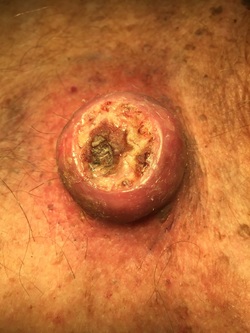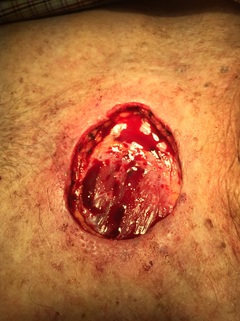Squamous Cell Carcinoma of the Skin
I. Definition:
A squamous cell carcinoma of the skin is a form of skin cancer which is usually the result of long term sun damage to the skin. Squamous cell carcinomas enlarge slowly and steadily and can invade neighboring tissue, like the eye. They can also spread to distant parts of the body (metastasize) if not treated early. The only way to tell for sure if a skin growth is cancerous is to biopsy it. This involves removing a small piece of the skin and having a pathologist look at it under the microscope in a medical laboratory. A biopsy does not remove the cancer, it only takes off the very top (like the tip of an iceberg). Sometimes the skin will heal after the biopsy because it grows over the cancer. This does not mean the cancer is gone, it means the cancer is now covered with a blanket of skin. If the cancer is not removed completely it can go deep into the skin and metastasize to the internal organs causing death.
II. Causes:
* Repeated, prolonged sun exposure causes skin damage which may develop into squamous cell carcinoma.
* The sun damage responsible for a squamous cell carcinoma usually occurred years before the cancer begins.
* Squamous cell carcinomas are most common on the face because the face receives more sunlight than other parts of the body.
* Fair-skinned individuals are more prone to skin cancer than darker persons, since skin pigment protects the skin. Persons of African ancestry with very dark skin practically never get squamous cell carcinoma of the skin.
* People who get one squamous cell carcinoma are likely to develop more. Often people will develop a second squamous cell carcinoma close to the spot were one has been treated because the surrounding skin is just as damaged by the sun as the skin where the first squamous cell carcinoma grew.
III. Prevention:
* Sun exposure and sunbathing produce gradual skin damage even if sunburn is avoided. Ten to forty years can pass between the time of sun exposure and the development of a squamous cell skin cancer.
* Sun damage is permanent and irreversible. You should put on sun-screen or moisturizer with an SPF of 15 or higher everyday before leaving the house. Don't go overboard and try to avoid the sun completely. The damage is already done; a little more sun will not make much difference.
* People who have had a squamous cell carcinoma need to come back every three months for two years for a skin exam and then every six months for life. Most recurrences are in the first two years.
IV. Treatment:
* After a biopsy has been done and a squamous cell carcinoma is found by the pathologist, the tumor needs to be removed. Squamous cell carcinomas are not cured by doing a biopsy. The skin will often heal after a biopsy. This is because the skin grows over the cancer like a blanket - further surgery is required. Surgery always leaves a scar. There is no way to remove a squamous cell carcinoma without leaving a scar. Often the scar can be hidden in the skin folds. Squamous cell carcinomas are often much bigger under the skin then they appear on the surface. What one can see on the surface is only the tip of the iceberg. That is why the hole left after removing a squamous cell cancer is often much larger than what can be seen before surgery.
* The most important point about skin cancer is it needs to be completely removed. Many people have lost body parts because of these tumors and some people have lost their lives.
* After the cancer is removed, the patient needs to be closely monitored. Even if the cancer is removed, there is a chance the cancer has all ready spread to other body areas. You need to see the doctor every three months for two years for a skin exam and then every six months for life.
A squamous cell carcinoma of the skin is a form of skin cancer which is usually the result of long term sun damage to the skin. Squamous cell carcinomas enlarge slowly and steadily and can invade neighboring tissue, like the eye. They can also spread to distant parts of the body (metastasize) if not treated early. The only way to tell for sure if a skin growth is cancerous is to biopsy it. This involves removing a small piece of the skin and having a pathologist look at it under the microscope in a medical laboratory. A biopsy does not remove the cancer, it only takes off the very top (like the tip of an iceberg). Sometimes the skin will heal after the biopsy because it grows over the cancer. This does not mean the cancer is gone, it means the cancer is now covered with a blanket of skin. If the cancer is not removed completely it can go deep into the skin and metastasize to the internal organs causing death.
II. Causes:
* Repeated, prolonged sun exposure causes skin damage which may develop into squamous cell carcinoma.
* The sun damage responsible for a squamous cell carcinoma usually occurred years before the cancer begins.
* Squamous cell carcinomas are most common on the face because the face receives more sunlight than other parts of the body.
* Fair-skinned individuals are more prone to skin cancer than darker persons, since skin pigment protects the skin. Persons of African ancestry with very dark skin practically never get squamous cell carcinoma of the skin.
* People who get one squamous cell carcinoma are likely to develop more. Often people will develop a second squamous cell carcinoma close to the spot were one has been treated because the surrounding skin is just as damaged by the sun as the skin where the first squamous cell carcinoma grew.
III. Prevention:
* Sun exposure and sunbathing produce gradual skin damage even if sunburn is avoided. Ten to forty years can pass between the time of sun exposure and the development of a squamous cell skin cancer.
* Sun damage is permanent and irreversible. You should put on sun-screen or moisturizer with an SPF of 15 or higher everyday before leaving the house. Don't go overboard and try to avoid the sun completely. The damage is already done; a little more sun will not make much difference.
* People who have had a squamous cell carcinoma need to come back every three months for two years for a skin exam and then every six months for life. Most recurrences are in the first two years.
IV. Treatment:
* After a biopsy has been done and a squamous cell carcinoma is found by the pathologist, the tumor needs to be removed. Squamous cell carcinomas are not cured by doing a biopsy. The skin will often heal after a biopsy. This is because the skin grows over the cancer like a blanket - further surgery is required. Surgery always leaves a scar. There is no way to remove a squamous cell carcinoma without leaving a scar. Often the scar can be hidden in the skin folds. Squamous cell carcinomas are often much bigger under the skin then they appear on the surface. What one can see on the surface is only the tip of the iceberg. That is why the hole left after removing a squamous cell cancer is often much larger than what can be seen before surgery.
* The most important point about skin cancer is it needs to be completely removed. Many people have lost body parts because of these tumors and some people have lost their lives.
* After the cancer is removed, the patient needs to be closely monitored. Even if the cancer is removed, there is a chance the cancer has all ready spread to other body areas. You need to see the doctor every three months for two years for a skin exam and then every six months for life.

